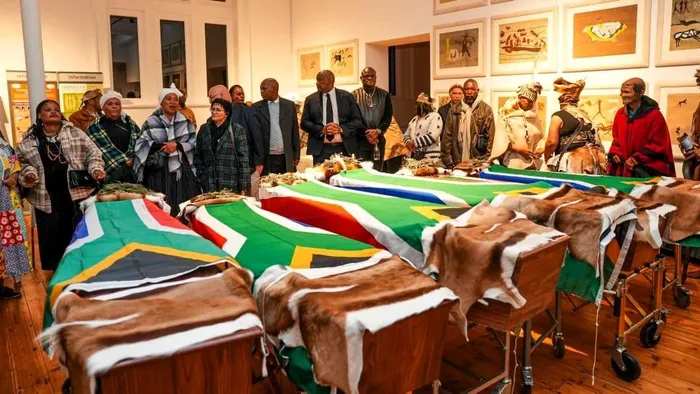Khoi and San ancestors come home: Northern Cape to lay five to rest in Steinkopf

Representatives of the Khoi and San descendant communities gather around caskets draped in the South African flag at the Iziko South African Museum in Cape Town, during the homecoming ceremony for the ancestral remains repatriated from the University of Glasgow’s Hunterian Museum.
Image: Northern Cape Provincial Government / Facebook
THE NORTHERN Cape this week marked a profound moment of remembrance and redress with the return of ancestral Khoi and San remains from the Hunterian Museum at the University of Glasgow in Scotland — an act officials describe as both repatriation and healing.
The formal homecoming ceremony took place at the Iziko South African Museum in Cape Town on October 17, following solemn traditional rites performed at Cape Town International Airport’s cargo terminal to welcome the ancestors back onto home soil.
Northern Cape Premier Zamani Saul framed the return as a necessary step towards justice and restoration. “True reconciliation demands justice. It demands the return of what was taken, be it remains, land, or dignity,” he said.
“This repatriation is us healing the scars of colonialism, and the scars of apartheid that are still with us. On December 16, 2025, the remains will finally return home to their resting place in Steinkopf, Namaqualand.”
The remains and associated items were unethically exhumed between 1868 and 1924 and later deposited with the University of Glasgow by alumni and other donors. According to the Department of Sport, Arts and Culture, what has been returned from the Hunterian collection comprises the partial remains of six individuals, two plaster face-casts and a soapstone smoking pipe excavated from a burial cairn. Five of the individuals — and the pipe — originate from the Northern Cape and are claimed by descendant members of the San, Nama, Griqua and Korana communities.
An additional set of remains originates from the Western Cape and is of Khoi San origin, believed to be considerably older and excavated from within a cave. The origin of the two face-casts is unknown, though they are thought to have been purchased in Edinburgh.
The homecoming — witnessed by Minister of Sport, Arts and Culture, Gayton McKenzie, Premier Saul, Northern Cape MEC for Sport, Arts and Culture Mangaliso Matika, and the executive mayor of the Namakwa District — represents the first implementation milestone of South Africa’s National Policy on Repatriation of Human Remains and Heritage Objects. The policy, recently endorsed, creates a co-ordinated, state-led framework for country-to-country repatriations and restitution from foreign institutions such as museums.
Iziko Museums of South Africa and the South African Heritage Resources Agency partnered with the Northern Cape Reburial Task Team to bring the project to completion and to support a culturally appropriate process led by descendant communities. The spiritual reception at the airport underscored that leadership: a ritual moment signifying the ancestors’ reunification with their homeland before the formal proceedings at Iziko.
For the Northern Cape, December 16, 2025, will be a date of closure and honour, when the five individuals connected to the province are to be laid to rest in Steinkopf, Namaqualand. The province has described the occasion as part of a broader effort to restore dignity to the country’s first peoples — after more than 150 years in which human remains were removed, studied and displayed far from their communities of origin.
Minister Gayton McKenzie addresses the audiences at the formal programme of the Homecoming Ceremony at the Iziko South African Museum.